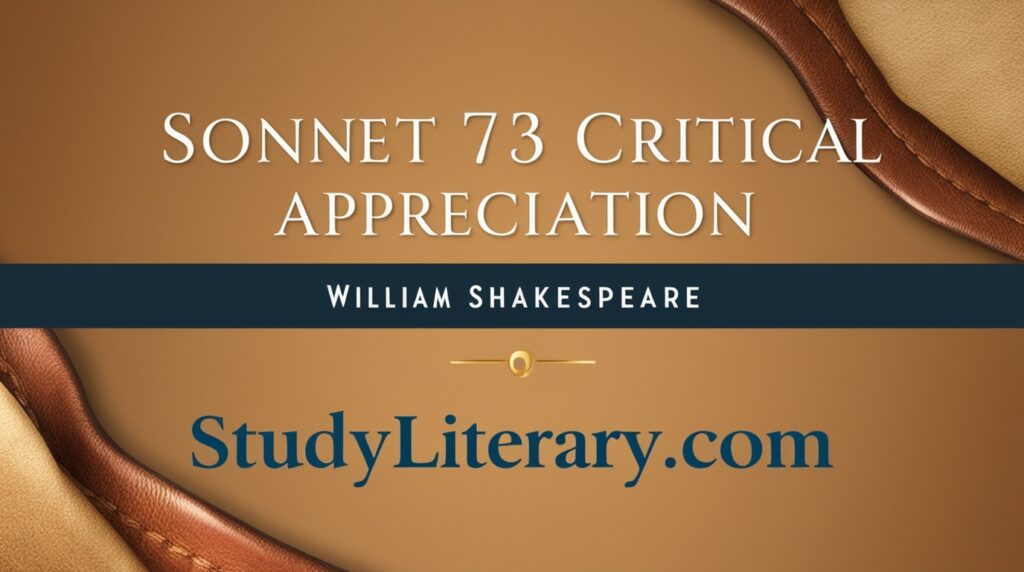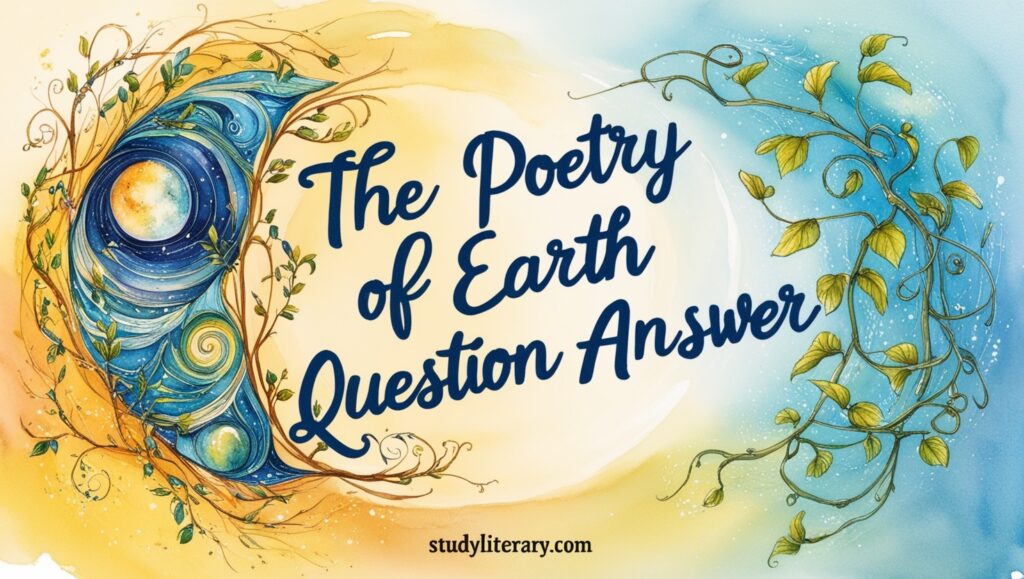
Sonnet 73 Critical Appreciation
Introduction
William Shakespeare’s Sonnet 73 is one of his most celebrated and profound poems, focusing on themes of aging, mortality, and the passage of time. The sonnet is part of his collection of 154 sonnets, which primarily explore love, beauty, time, and mortality. In Sonnet 73, the speaker reflects on the inevitable decline associated with aging, using powerful imagery and metaphors. The poem is written in the traditional Shakespearean sonnet form, which consists of three quatrains and a rhyming couplet, following the rhyme scheme ABABCDCDEFEFGG. The sonnet’s structure, imagery, and thematic depth contribute to its enduring significance in literature.
Structure and Form
Sonnet 73 adheres to the classic Shakespearean sonnet form, comprising 14 lines of iambic pentameter divided into three quatrains followed by a concluding rhymed couplet. Each quatrain presents a different metaphor to convey the idea of aging and impending death. The progression from one quatrain to the next is both logical and thematic, leading the reader through a journey from late autumn to twilight and finally to a dying fire. The final couplet then offers a resolution that ties together the sonnet’s themes, emphasizing the strength of love in the face of mortality.
The use of iambic pentameter gives the poem a steady, rhythmic flow, which mirrors the passage of time. This metrical structure is typical of Shakespeare’s sonnets and allows for a natural and expressive reading. The sonnet’s rhyme scheme enhances its musicality, creating a sense of closure with the couplet that resolves the contemplative tension built in the preceding quatrains.
Quatrain 1: The Metaphor of Autumn
The first quatrain introduces the metaphor of late autumn, a time when leaves have either fallen or are clinging weakly to the branches:
“That time of year thou mayst in me behold, / When yellow leaves, or none, or few, do hang / Upon those boughs which shake against the cold, / Bare ruined choirs, where late the sweet birds sang.”
The imagery here is stark and desolate, evoking the barrenness of nature as it approaches winter. The “yellow leaves” symbolize the final stages of life, clinging to the branches before inevitably falling. The phrase “bare ruined choirs” is particularly poignant, as it suggests the empty shells of structures that were once filled with life and vibrancy, much like the speaker’s body, which has now become aged and worn.
The use of autumn as a metaphor for old age is both apt and evocative. Autumn is a transitional season, representing the movement from the fullness of summer to the cold emptiness of winter. Similarly, the speaker is in the later stages of life, nearing the inevitable “winter” of death. The contrast between the past, symbolized by the “sweet birds” that once sang, and the present barrenness heightens the sense of loss and decay.
Quatrain 2: The Metaphor of Twilight
In the second quatrain, the speaker shifts to the metaphor of twilight, the fading light of day that heralds the coming of night:
“In me thou seest the twilight of such day / As after sunset fadeth in the west, / Which by and by black night doth take away, / Death’s second self, that seals up all in rest.”
Twilight, a transitional time between day and night, represents the final years of life, where the brightness of youth has already faded, leaving only a dim glow before total darkness (death) sets in. The “black night” is personified as “death’s second self,” a quiet force that “seals up all in rest,” suggesting the peaceful yet inevitable closure that death brings.
This metaphor is especially powerful because it conveys the natural progression of time—just as day gives way to night, life gives way to death. The imagery of the setting sun and the fading light reinforces the idea that time is irreversible, and that the speaker is nearing the end of his life. The use of the word “seals” is significant, as it implies a final, unchangeable closure, leaving no room for reversal or renewal.
Quatrain 3: The Metaphor of a Dying Fire
The third quatrain introduces the final metaphor, that of a dying fire:
“In me thou seest the glowing of such fire / That on the ashes of his youth doth lie, / As the deathbed whereon it must expire, / Consumed with that which it was nourished by.”
Here, the fire, once blazing with the energy of youth, has now been reduced to glowing embers, slowly being extinguished. The ashes represent the remnants of the speaker’s youth, now reduced to memories. The image of a “deathbed” suggests that the fire is in its final moments, soon to be completely extinguished. The paradox in the line “Consumed with that which it was nourished by” highlights the idea that the same force that once fueled life—time—also leads to its end.
The metaphor of the dying fire is rich in symbolism. Fire is traditionally associated with passion, energy, and life, but in this context, it is waning and approaching its end. The transition from a vibrant, roaring flame to mere embers encapsulates the inevitable decline that accompanies aging. The metaphor emphasizes that the very essence of life—time—eventually consumes itself, leaving nothing but cold ashes behind.
The Concluding Couplet: The Power of Love
The sonnet concludes with a rhyming couplet that offers a resolution to the meditations on aging and death:
“This thou perceiv’st, which makes thy love more strong, / To love that well which thou must leave ere long.”
The speaker directly addresses the beloved, suggesting that the awareness of life’s transience strengthens love. The couplet serves as a poignant reminder that love becomes more meaningful when time is limited. The inevitability of death makes the moments of life and love more precious. In this way, the poem shifts from a somber reflection on aging to a celebration of love’s power to endure even in the face of mortality.
The couplet’s affirmation of love provides a sense of closure and balance to the poem. While the first three quatrains dwell on decline and loss, the couplet suggests that love transcends these limitations, offering a source of strength and resilience. The use of the word “must” in “must leave ere long” underscores the inevitability of death, but the emphasis on loving “well” suggests that this knowledge should inspire a deeper, more intense appreciation of life and love.
Thematic Depth and Universal Significance
Sonnet 73’s exploration of aging and mortality is deeply personal, yet it carries universal significance. The metaphors of autumn, twilight, and a dying fire are not just representations of the speaker’s individual experience; they reflect the broader human condition. The poem speaks to the inevitability of aging and death, themes that resonate with all readers. Despite its focus on decline, the sonnet ultimately affirms the value of love and the importance of cherishing the time we have.
The sonnet’s universal message is conveyed through its carefully crafted imagery and structure. The gradual progression from one metaphor to the next mirrors the natural progression of life, while the final couplet offers a consoling reminder that love can provide meaning even in the face of life’s transience. In this way, Sonnet 73 transcends its specific context, offering a timeless meditation on the human experience.
Conclusion
Shakespeare’s Sonnet 73 is a masterful exploration of aging, mortality, and the enduring power of love. Through its rich metaphors, precise structure, and eloquent language, the sonnet captures the melancholy of approaching death while affirming the strength of love in the face of life’s inevitable decline. The poem’s ability to evoke deep emotional responses and its reflection on universal themes make it one of Shakespeare’s most enduring and profound works.

